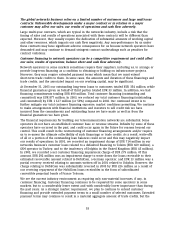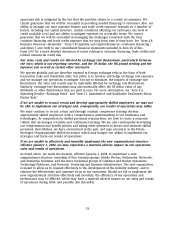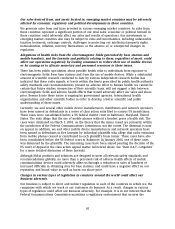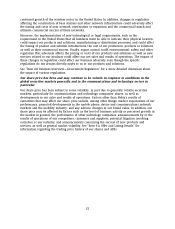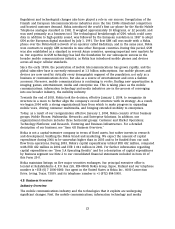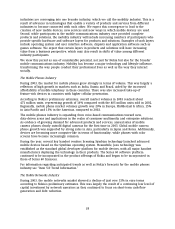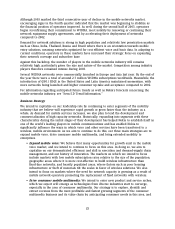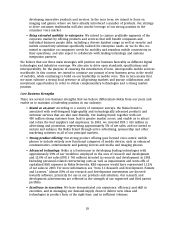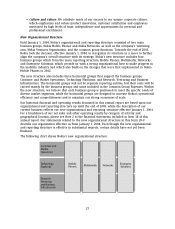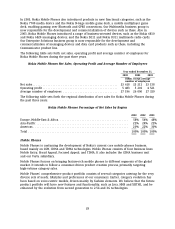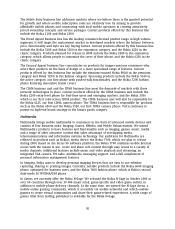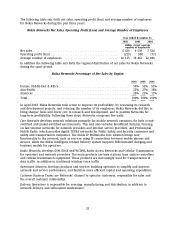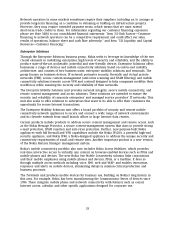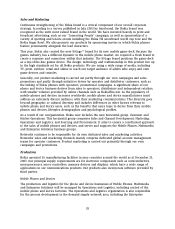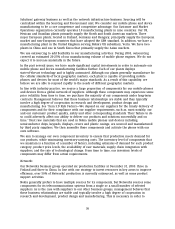Nokia 2003 Annual Report Download - page 29
Download and view the complete annual report
Please find page 29 of the 2003 Nokia annual report below. You can navigate through the pages in the report by either clicking on the pages listed below, or by using the keyword search tool below to find specific information within the annual report.Business Groups
Mobile Phones develops mobile phones for all major standards and customer segments in over 130
countries. Mobile Phones is made up of four of the nine business units from the former Nokia
Mobile Phones: Mobile Phones, Mobile Entry Products, CDMA, and TDMA. Mobile Phones also
includes our Vertu subsidiary. The remaining five business units from the former Nokia Mobile
Phones were transferred to other business groups in the reorganization, as described below.
Multimedia focuses on bringing mobile multimedia to consumers in the form of advanced mobile
devices. It combines four business units from the former Nokia Mobile Phones: Imaging,
Entertainment and Media, Mobile Enhancements and Mobile Services, with Nokia Home
Communications, formerly a unit located within the Nokia Ventures Organization.
Networks is a leading provider of network infrastructure, service delivery platforms and related
services to mobile operators and service providers. Focusing on the GSM family of technologies, the
group aims at leadership in GSM, EDGE and WCDMA networks. Pursuant to the reorganization,
Networks carries on the business of the former Nokia Networks.
Enterprise Solutions offers businesses a range of devices and mobile connectivity solutions based on
end-to-end mobility architecture. It combines the Business Applications business unit from the
former Nokia Mobile Phones with Nokia Internet Communications and Nokia One, formerly units
located within Nokia Ventures Organization.
Horizontal Groups
Customer and Market Operations includes Nokia’s sales and marketing organization as well as
manufacturing, logistics and sourcing. They have been organized globally to serve and support the
three mobile phone and device related business groups: Mobile Phones, Multimedia and Enterprise
Solutions. The Networks business group continues to have its own dedicated sales and marketing,
logistics and sourcing activities.
Technology Platforms is responsible for Nokia-wide technology management and development. It
delivers leading technologies and platforms to Nokia’s business groups and external customers.
The Mobile Software Unit is now operating within this horizontal group.
Research, Venturing and Business Infrastructure includes the Nokia Research Center, Nokia Ventures
Organization, Business Infrastructure, and Operating Resource Sourcing.
Nokia Mobile Phones in 2003
For 2003, the total mobile phone sales volumes achieved by the former Nokia Mobile Phones
reached a record level of 179.3 million units, representing growth of 18% compared with 2002.
Based on an estimated global sell-through market for mobile phones of 471 million units, Nokia’s
global market share was slightly above 38% for 2003, compared with 38% for 2002.
In 2003, key product announcements in GSM technology included the Nokia 6108 pen-based phone
for the Chinese market, which is the first phone enabling text input, handwriting recognition and
predictive text in English and Chinese; the Nokia 3200, the company’s first high-volume, affordable
camera phone; the Nokia 7600, a WCDMA/GSM dual mode phone; the Nokia 6600 imaging phone,
and Nokia’s first Push-to-Talk model, the Nokia 5140.
In 2003, Nokia began shipping the entry-level Nokia 2200 Series CDMA phones, designed for
first-time users and emerging markets, and Nokia’s first color screen CDMA product, the Nokia
3586 phone. Nokia also announced its first CDMA camera phone in 2003, the Nokia 6225; while in
other technologies, important launches included the Nokia 3520, our first TDMA color display
phone.
28


